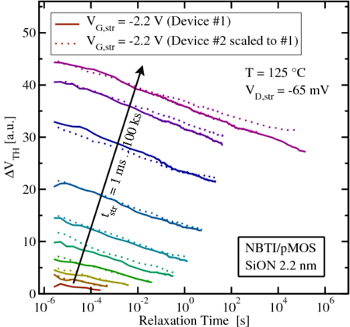
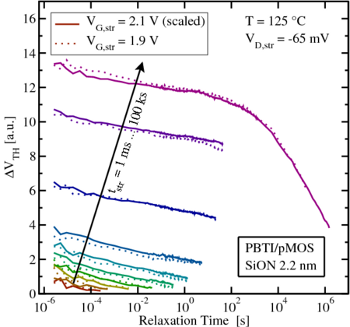
 . Note that degradation data
obtained with equal absolute values of the oxide electric field are compared
here.
. Note that degradation data
obtained with equal absolute values of the oxide electric field are compared
here.
As the time constant distribution of the microscopic defects behind BTI turn out to be a key issue, the apparent differences in relaxation behavior of negative and positive BTI (NBTI and PBTI) on pMOSFETs, as depicted in Fig. 7.1, are now examined under that perspective.


 . Note that degradation data
obtained with equal absolute values of the oxide electric field are compared
here.
. Note that degradation data
obtained with equal absolute values of the oxide electric field are compared
here.
Although PBTI on pMOSFETs is not regarded as technologically important as NBTI, it provides a valuable probe of the underlying physical degradation mechanism. The most intriguing observation is that both negative and positive bias stress create positive charges in the oxide [30], which was already demonstrated in Chapter 4.2. However, so far the NBTI and PBTI stress conditions were only compared in a qualitative way, i.e. strong inversion was usually opposed to strong accumulation with undetermined specifications concerning the exact gate voltages or oxide electric fields applied.
For a quantitative analysis of the recovery following NBTI and PBTI
stress, long stress times  between
between  and
and  are essential. The
same technology (
are essential. The
same technology ( -
- -pMOSFET) as used in Chapter 6 was
compared by the fast-
-pMOSFET) as used in Chapter 6 was
compared by the fast- method of [15] using three different oxide
thicknesses (
method of [15] using three different oxide
thicknesses ( and
and  ) and the corresponding
geometries of
) and the corresponding
geometries of  and
and  at
a constant temperature of
at
a constant temperature of  . Depending on the oxide thickness
the same applied stress voltage causes a totally different oxide electric
field. This is due to capacity of the MOSFET with its principle already
explained in Chapter 2.6. The resulting electric field at the surface of the
semiconductor
. Depending on the oxide thickness
the same applied stress voltage causes a totally different oxide electric
field. This is due to capacity of the MOSFET with its principle already
explained in Chapter 2.6. The resulting electric field at the surface of the
semiconductor  can be experimentally estimated by using the following
relation:
can be experimentally estimated by using the following
relation:
 | (7.1) |
where  denotes the capacity of the MOSFET,
denotes the capacity of the MOSFET,  the flatband voltage,
and
the flatband voltage,
and  and
and  the width and length of the device. The
the width and length of the device. The  -characteristics
and the corresponding electric field are shown in Fig. 7.2 for the different device
geometries with a constant flatband voltage of
-characteristics
and the corresponding electric field are shown in Fig. 7.2 for the different device
geometries with a constant flatband voltage of  . From this figure it can
further be seen that in addition to the nonzero flatband voltage the electric field
during NBTI and PBTI is not symmetric. To create comparable degradation
conditions (not comparable degradation shifts) for both NBTI and PBTI, the
same effective field is of interest, i.e. the same magnitude, but opposite sign.
Based on the experimental
. From this figure it can
further be seen that in addition to the nonzero flatband voltage the electric field
during NBTI and PBTI is not symmetric. To create comparable degradation
conditions (not comparable degradation shifts) for both NBTI and PBTI, the
same effective field is of interest, i.e. the same magnitude, but opposite sign.
Based on the experimental  -characteristics in Fig. 7.2 the required
stress voltage
-characteristics in Fig. 7.2 the required
stress voltage  can be obtained for both NBTI and PBTI. As
an example, to achieve an
can be obtained for both NBTI and PBTI. As
an example, to achieve an  for
for  gate
voltages of
gate
voltages of  for PBTI and
for PBTI and  for NBTI have to be
applied.
for NBTI have to be
applied.
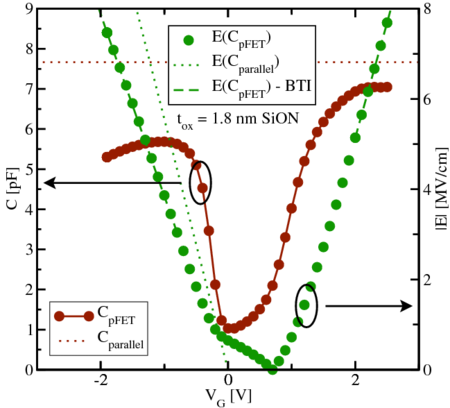
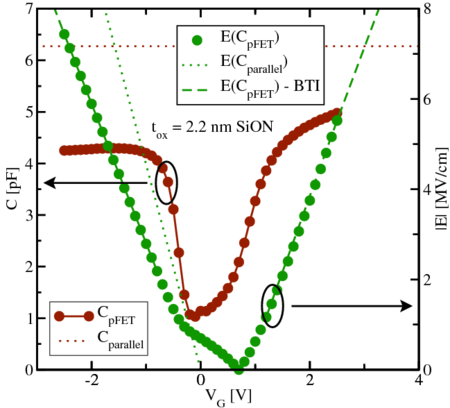
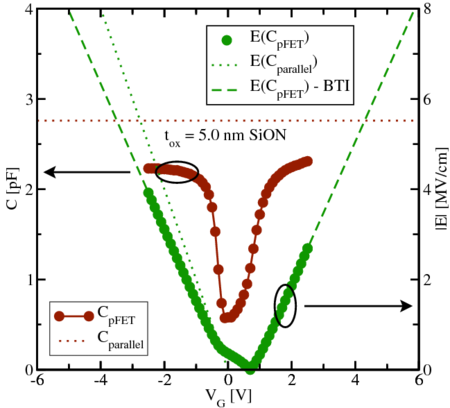
 -characteristics. Larger area devices with a
-characteristics. Larger area devices with a  have to be used to get satisfactory signal-to-noise ratios. The three oxide
thicknesses are
have to be used to get satisfactory signal-to-noise ratios. The three oxide
thicknesses are  (Top),
(Top),  (Center), and
(Center), and  (Bottom).
Though the oxide is slightly nitrided (6%), the
(Bottom).
Though the oxide is slightly nitrided (6%), the  of
of  was used to
calculate the oxide electric fields
was used to
calculate the oxide electric fields  , using a flatband voltage of
, using a flatband voltage of  .
The capacitance of the limiting case of an ideal parallel plate capacitor of
the same thickness is plotted for comparison.
.
The capacitance of the limiting case of an ideal parallel plate capacitor of
the same thickness is plotted for comparison.
